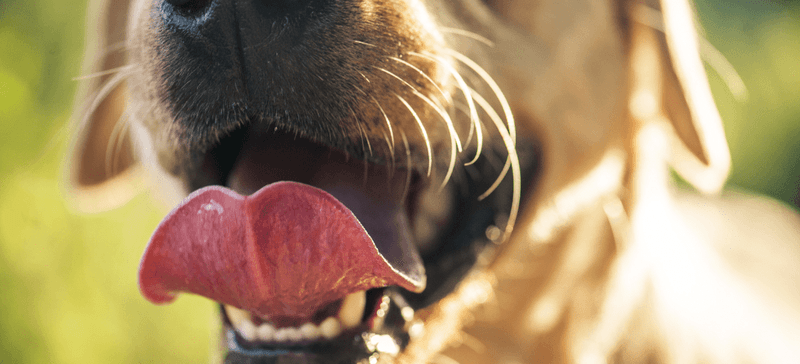14 Sneaky Changes in Dogs That Veterinarians Take Very Seriously
Our furry friends can’t tell us when they’re feeling under the weather. Instead, they rely on subtle body language and behavior changes that are easy to miss if you’re not paying close attention.
Veterinarians are trained to spot these sneaky signs that might indicate serious health problems in dogs. Learning to recognize these warning signals could help you catch potential issues early, potentially saving your pup from unnecessary suffering and you from costly emergency vet bills.
1. Bad breath that’s getting worse
Foul doggy breath isn’t just an unpleasant nuisance—it’s often a red flag for dental disease or other health problems. When bacteria build up on your dog’s teeth, they create plaque that hardens into tartar, causing inflammation and infection in the gums.
Advanced dental disease can lead to tooth loss, painful abscesses, and even damage to internal organs as bacteria enter the bloodstream. Some dogs might drool more or paw at their mouths when experiencing dental pain.
Regular dental check-ups and at-home tooth brushing can prevent many of these issues. If your dog’s breath suddenly smells worse than usual, especially with a sweet or fruity odor, it could signal diabetes or kidney problems requiring immediate veterinary attention.
2. Slight limp or favoring a leg
Your pup might try to hide pain, but a subtle limp shouldn’t be ignored. Even if your dog continues playing and running, that minor hitch in their step could signal joint problems, ligament tears, or even bone cancer.
Many owners dismiss minor limping, assuming their dog just played too hard or slept awkwardly. However, veterinarians know that early intervention for mobility issues can prevent more serious damage and chronic pain.
Watch for other changes like reluctance to climb stairs, difficulty getting into the car, or decreased interest in walks. If the limp persists for more than 24 hours or comes and goes over several days, it’s time for a professional evaluation rather than waiting to see if it resolves on its own.
3. Changes in eating or drinking habits
Skipping meals or suddenly emptying the water bowl multiple times a day can reveal hidden health problems. A dog that’s always been food-motivated who suddenly turns away from favorite treats might be experiencing nausea, dental pain, or digestive issues.
Increased thirst often points to kidney disease, diabetes, or hormonal imbalances like Cushing’s disease. Similarly, a ravenous appetite in a dog that’s losing weight could indicate problems absorbing nutrients or conditions like diabetes or hyperthyroidism.
Keep track of how much your dog eats and drinks normally so changes are easier to spot. Veterinarians consider these altered patterns crucial diagnostic clues that warrant blood work and other tests to catch diseases in their early, more treatable stages.
4. Subtle weight gain or loss
Gradual weight changes can sneak up on pet parents who see their dogs daily. A dog gaining weight despite normal food portions might have a thyroid condition or hormone imbalance affecting metabolism.
Weight loss is particularly concerning when it happens without dietary changes. Unexplained thinning could signal digestive disorders preventing proper nutrient absorption, cancer, kidney disease, or diabetes. Senior dogs naturally lose some muscle mass with age, but rapid or significant changes aren’t normal aging.
Monthly weigh-ins at home can help catch trends early. Use a bathroom scale (weigh yourself holding your dog, then subtract your weight) or regular vet check-ins. Weight changes of more than 10% deserve professional attention, even if your dog seems otherwise healthy.
5. New lumps or bumps
Finding an unexpected bump while petting your dog can be alarming. While many growths are harmless fatty tumors (lipomas), others can be dangerous cancers that spread quickly if not addressed.
Monthly home checks help catch new lumps early. Run your hands over your dog’s entire body, noting any raised areas. Mark the size of new findings with a pen on the surrounding fur or measure with a ruler and take photos to monitor changes.
Veterinarians can perform simple tests like needle aspirations to identify concerning masses. They look for warning signs such as rapid growth, irregular borders, firmness, or attachment to underlying tissues. Early detection dramatically improves outcomes for many canine cancers, making regular body checks a potentially life-saving habit.
6. Changes in bark or vocalization
A hoarse bark or unusual sounds from your normally vocal pup warrant attention. Voice changes can indicate laryngeal issues, respiratory infections, or growths affecting the vocal cords.
Some dogs develop a honking cough from collapsed trachea or kennel cough, while others might whimper or whine when experiencing pain they can’t otherwise communicate. A previously quiet dog that starts vocalizing more, especially at night, might be experiencing cognitive changes, vision loss, or discomfort.
Record unusual sounds on your phone to play for your veterinarian. This documentation helps with diagnosis since many voice changes happen intermittently. Voice changes accompanied by difficulty breathing, excessive panting, or blue-tinged gums require emergency care as they may indicate dangerous airway obstruction.
7. More sleeping or restlessness
Changes in your dog’s energy level or sleep patterns often fly under the radar. A normally active dog who starts sleeping more during the day might be experiencing pain, illness, or age-related cognitive decline.
Conversely, a dog that can’t settle at night, paces, or seems confused could be suffering from anxiety, vision problems, or canine cognitive dysfunction (similar to dementia in humans). Senior dogs naturally slow down, but dramatic energy shifts at any age deserve medical evaluation.
Keep a simple log of your dog’s activity for a week if you notice changes. Note sleep duration, play sessions, and restless periods to show your veterinarian. Blood tests can rule out medical causes like thyroid disorders or anemia that might be affecting your dog’s energy and comfort levels.
8. Scooting or excessive licking
That embarrassing butt-drag across your carpet isn’t just a quirky dog behavior—it’s your pet’s attempt to relieve discomfort. Scooting typically signals anal gland issues, where these small scent-producing sacs become impacted or infected, causing irritation.
Similarly, when dogs repeatedly lick or chew at specific body areas, they’re trying to soothe themselves. Hot spots, allergies, joint pain, or skin infections often trigger this behavior. Paw-licking might indicate allergies or something stuck between toe pads.
Owners frequently miss the early stages of these behaviors or consider them normal dog quirks. Veterinarians recognize them as communication about discomfort that needs addressing. Prompt treatment prevents self-trauma from excessive licking and chewing that can create wounds and bacterial infections requiring more intensive treatment.
9. Shaking head or pawing at ears
Head shaking and ear pawing signal ear trouble brewing. Dogs with floppy ears are especially prone to ear infections, but any breed can develop painful inflammation from allergies, moisture, or parasites like ear mites.
Left untreated, ear infections can spread deeper into the ear canal, potentially causing balance issues, hearing loss, or even neurological problems. The dark, warm environment inside dog ears creates perfect conditions for yeast and bacteria to multiply rapidly.
Check your dog’s ears weekly for redness, swelling, discharge, or unusual odor. Gently lift the ear flap and look for healthy pink tissue without excessive wax or debris. Chronic ear problems might indicate underlying food allergies or hormonal conditions requiring more comprehensive treatment beyond just ear medication.
10. Change in coat texture or shine
A dull, brittle coat or excessive shedding often reflects internal health problems before other symptoms appear. Hormonal imbalances like hypothyroidism or Cushing’s disease typically cause dramatic coat changes, including hair loss or thinning fur that doesn’t regrow after clipping.
Nutritional deficiencies can also manifest in poor coat quality. Dogs need specific proteins, fatty acids, and vitamins for healthy skin and fur. Sudden increased shedding (beyond seasonal changes) or dry, flaky skin might indicate allergies or immune system problems.
Regularly run your hands through your dog’s coat to feel for changes in texture. Veterinarians often spot subtle coat abnormalities during routine exams that owners miss. Blood tests can identify underlying causes, and addressing them typically restores coat health within a few months.
11. Subtle behavior shifts
A formerly social dog who starts hiding under the bed or a cuddly pup who suddenly snaps when touched may be trying to tell you something’s wrong. Pain, vision loss, or neurological changes often manifest first as personality shifts rather than obvious physical symptoms.
Anxiety behaviors like excessive panting, trembling, or destructiveness when left alone can develop from hearing loss, cognitive dysfunction, or physical discomfort. Dogs instinctively hide weakness, so these behavior changes may be their only way of communicating distress.
Start a behavior journal if you notice changes. Note triggers, frequency, and patterns to help your veterinarian determine whether the cause is medical or behavioral. Many owners regret ignoring early behavior changes that were actually their dog’s first attempt to signal a serious health problem.
12. Persistent cough or throat clearing
An occasional cough isn’t concerning, but regular throat clearing or a cough that lasts more than a few days signals potential trouble. Heart disease often manifests first as a soft, persistent cough that worsens at night or during exercise as fluid builds up in the lungs.
Kennel cough produces a distinctive honking sound, while collapsing trachea causes a goose-like honk typically triggered by excitement or pulling on a leash. Older small breeds commonly develop this condition as cartilage weakens.
Record coughing episodes to help your veterinarian determine the cause. Note what triggers episodes and when they occur. Chest X-rays can reveal heart enlargement, lung problems, or foreign objects. Catching respiratory issues early prevents progression to more serious breathing difficulties that might require emergency intervention.
13. Difficulty standing up or lying down
When your dog starts taking longer to rise from rest or circles repeatedly before carefully lowering down, joint pain is likely the culprit. These mobility changes often develop gradually, making them easy to dismiss as normal aging rather than treatable medical conditions.
Arthritis affects most senior dogs but can start in middle age, especially in larger breeds or those with previous injuries. Intervertebral disc disease causes similar symptoms but results from spinal issues rather than joint inflammation. Both conditions cause significant pain that dogs instinctively hide.
Watch for reluctance to jump onto furniture, stiffness after rest that improves with movement, or difficulty with stairs. Early intervention with joint supplements, appropriate exercise, weight management, and pain medication can dramatically improve quality of life and slow progression of these degenerative conditions.
14. Cloudiness in the eyes
A bluish haze developing in your dog’s eyes isn’t always just a normal aging change. While many senior dogs develop harmless lenticular sclerosis (a normal clouding of the lens), similar appearances can signal cataracts, glaucoma, or corneal ulcers requiring treatment.
Glaucoma causes pressure buildup that damages the optic nerve and can cause blindness within hours if not treated as an emergency. Signs include redness, squinting, or a visible difference in pupil size between eyes.
Regular eye checks at home help catch problems early. In good lighting, look for symmetrical appearance, clear surfaces, and normal pupil responses. Any sudden changes in eye appearance, excessive tearing, or signs your dog can’t see normally warrant immediate veterinary attention. Many eye conditions are treatable if caught early but cause permanent damage if ignored.




















